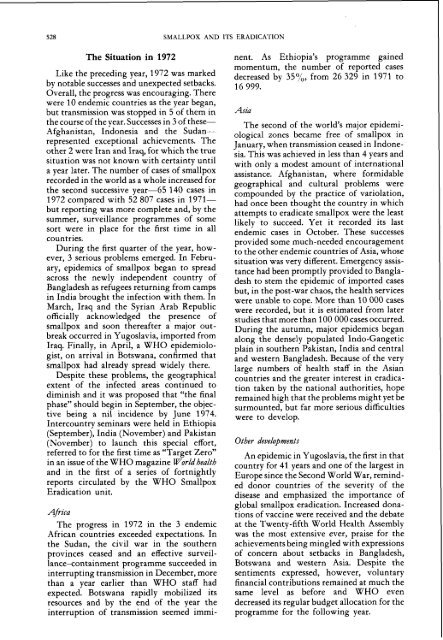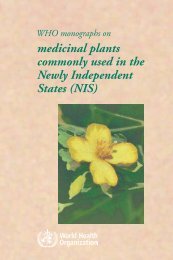smallpox eradication - libdoc.who.int - World Health Organization
smallpox eradication - libdoc.who.int - World Health Organization
smallpox eradication - libdoc.who.int - World Health Organization
You also want an ePaper? Increase the reach of your titles
YUMPU automatically turns print PDFs into web optimized ePapers that Google loves.
528 SMALLPOX AND 1 LTS ERADICATION<br />
The Situation in 1972<br />
Like the preceding year, 1972 was marked<br />
by notable successes and unexpected setbacks.<br />
Overall, the progress was encouraging. There<br />
were 10 endemic countries as the year began,<br />
but transmission was stopped in 5 of them in<br />
the course of the year. Successes in 3 of these-<br />
Afghanistan, Indonesia and the Sudanrepresented<br />
exceptional achievements. The<br />
other 2 were Iran and Iraq, for which the true<br />
situation was not known with certa<strong>int</strong>y until<br />
a year later. The number of cases of <strong>smallpox</strong><br />
recorded in the world as a <strong>who</strong>le increased for<br />
the second successive year-65 140 cases in<br />
1972 compared with 52 807 cases in 1971-<br />
but reporting was more complete and, by the<br />
summer, surveillance programmes of some<br />
sort were in place for the first time in all<br />
countries.<br />
During the first quarter of the year, however,<br />
3 serious problems emerged. In February,<br />
epidemics of <strong>smallpox</strong> began to spread<br />
across the newly independent country of<br />
Bangladesh as refugees returning from camps<br />
in India brought the infection with them. In<br />
March, Iraq and the Syrian Arab Republic<br />
officially acknowledged the presence of<br />
<strong>smallpox</strong> and soon thereafter a major outbreak<br />
occurred in Yugoslavia, imported from<br />
Iraq. Finally, in April, a WHO epidemiologist,<br />
on arrival in Botswana, confirmed that<br />
<strong>smallpox</strong> had already spread widely there.<br />
Despite these problems, the geographical<br />
extent of the infected areas continued to<br />
diminish and it was proposed that "the final<br />
phase" should begin in September, the objective<br />
being a nil incidence by June 1974.<br />
Intercountry seminars were held in Ethiopia<br />
(September), India (November) and Pakistan<br />
(November) to launch this special effort,<br />
referred to for the first time as "Target Zero"<br />
in an issue of the WHO magazine <strong>World</strong> health<br />
and in the first of a series of fortnightly<br />
reports circulated by the WHO Smallpox<br />
Eradication unit.<br />
The progress in 1972 in the 3 endemic<br />
African countries exceeded expectations. In<br />
the Sudan, the civil war in the southern<br />
provinces ceased and an effective surveillance-containment<br />
programme succeeded in<br />
<strong>int</strong>errupting transmission in December, more<br />
than a year earlier than WHO staff had<br />
expected. Botswana rapidly mobilized its<br />
resources and by the end of the year the<br />
<strong>int</strong>erruption of transmission seemed immi-<br />
nent. As Ethiopia's programme gained<br />
momentum, the number of reported cases<br />
decreased by 35%, from 26 329 in 1971 to<br />
16 999.<br />
Asia<br />
The second of the world's major epidemiological<br />
zones became free of <strong>smallpox</strong> in<br />
January, when transmission ceased in Indonesia.<br />
This was achieved in less than 4 years and<br />
with only a modest amount of <strong>int</strong>ernational<br />
assistance. Afghanistan, where formidable<br />
geographical and cultural problems were<br />
compounded by the practice of variolation,<br />
had once been thought the country in which<br />
attempts to eradicate <strong>smallpox</strong> were the least<br />
likely to succeed. Yet it recorded its last<br />
endemic cases in October. These successes<br />
provided some much-needed encouragement<br />
to the other endemic countries of Asia, <strong>who</strong>se<br />
situation was very different. Emergency assistance<br />
had been promptly provided to Bangladesh<br />
to stem the epidemic of imported cases<br />
but, in the post-war chaos, the health services<br />
were unable to cope. More than 10 000 cases<br />
were recorded, but it is estimated from later<br />
studies that more than l00 000 cases occurred.<br />
During the autumn, major epidemics began<br />
along the densely populated Indo-Gangetic<br />
plain in southern Pakistan, India and central<br />
and western Bangladesh. Because of the very<br />
large numbers of health staff in the Asian<br />
countries and the greater <strong>int</strong>erest in <strong>eradication</strong><br />
taken by the national authorities, hope<br />
remained high that the problems might yet be<br />
surmounted, but far more serious difficulties<br />
were to develop.<br />
Other developments<br />
An epidemic in Yugoslavia, the first in that<br />
country for 41 years and one of the largest in<br />
Europe since the Second <strong>World</strong> War, reminded<br />
donor countries of the severity of the<br />
disease and emphasized the importance of<br />
global <strong>smallpox</strong> <strong>eradication</strong>. Increased donations<br />
of vaccine were received and the debate<br />
at the Twenty-fifth <strong>World</strong> <strong>Health</strong> Assembly<br />
was the most extensive ever, praise for the<br />
achievements being mingled with expressions<br />
of concern about setbacks in Bangladesh,<br />
Botswana and western Asia. Despite the<br />
sentiments expressed, however, voluntary<br />
financial contributions remained at much the<br />
same level as before and WHO even<br />
decreased its regular budget allocation for the<br />
programme for the following year.
















